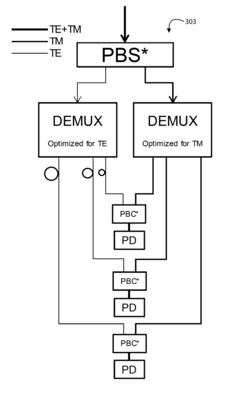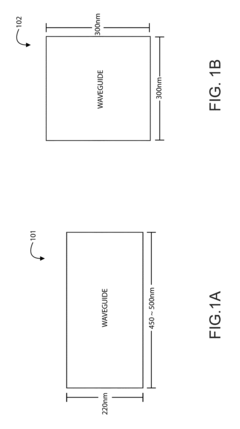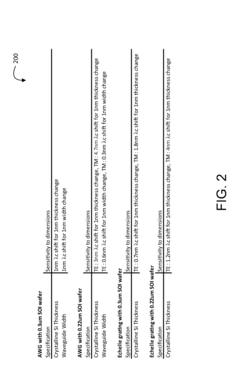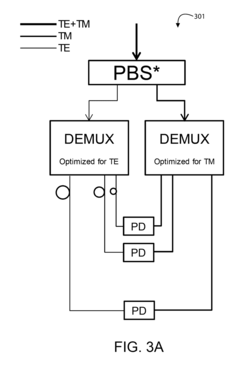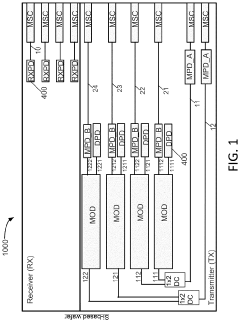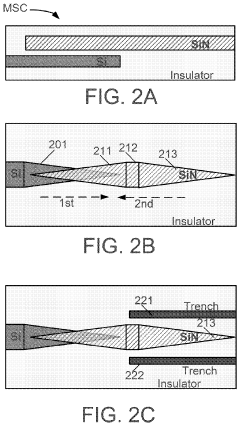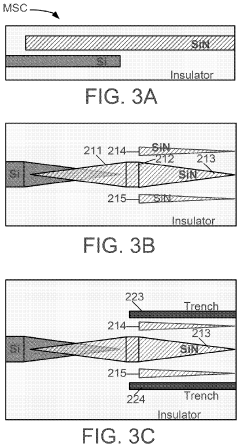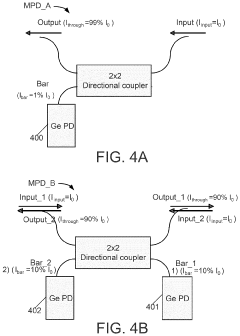How silicon photonics enhances public safety communication systems.
JUL 17, 20259 MIN READ
Generate Your Research Report Instantly with AI Agent
Patsnap Eureka helps you evaluate technical feasibility & market potential.
Silicon Photonics Evolution and Objectives
Silicon photonics has emerged as a transformative technology in the field of telecommunications, offering unprecedented capabilities for high-speed data transmission and processing. The evolution of silicon photonics can be traced back to the early 2000s when researchers began exploring the potential of integrating optical components with silicon-based electronic circuits. This convergence of optics and electronics on a single chip has since revolutionized the way we approach communication systems, including those critical for public safety.
The primary objective of silicon photonics in enhancing public safety communication systems is to provide faster, more reliable, and more secure data transmission capabilities. By leveraging the properties of light for data transfer, silicon photonics enables significantly higher bandwidth and lower latency compared to traditional electronic systems. This is particularly crucial in emergency situations where real-time communication and rapid data exchange can make the difference between life and death.
As the technology has progressed, several key milestones have been achieved. The development of efficient silicon-based modulators and photodetectors has been instrumental in enabling high-speed data transmission. Advances in waveguide technology have allowed for the precise manipulation of light signals on chip, while improvements in integration techniques have made it possible to combine multiple photonic and electronic components on a single platform.
The current trajectory of silicon photonics research is focused on further miniaturization, increased integration density, and improved energy efficiency. These advancements aim to create more compact, powerful, and cost-effective communication systems that can be deployed in a wide range of public safety applications. From enhancing the capabilities of emergency response networks to improving the reliability of critical infrastructure monitoring systems, silicon photonics is poised to play a pivotal role in safeguarding communities.
One of the most promising aspects of silicon photonics for public safety communications is its potential to enable robust, high-capacity networks that can withstand extreme conditions. The technology's inherent resistance to electromagnetic interference and its ability to operate over long distances with minimal signal degradation make it ideal for maintaining communication links during natural disasters or other emergency scenarios.
Looking ahead, the objectives for silicon photonics in public safety communication systems include developing more sophisticated integrated photonic circuits capable of advanced signal processing and encryption. This will not only enhance the speed and capacity of communication networks but also improve their security and resilience against cyber threats. Additionally, researchers are exploring ways to leverage silicon photonics for sensing applications, potentially enabling new capabilities in environmental monitoring and threat detection.
The primary objective of silicon photonics in enhancing public safety communication systems is to provide faster, more reliable, and more secure data transmission capabilities. By leveraging the properties of light for data transfer, silicon photonics enables significantly higher bandwidth and lower latency compared to traditional electronic systems. This is particularly crucial in emergency situations where real-time communication and rapid data exchange can make the difference between life and death.
As the technology has progressed, several key milestones have been achieved. The development of efficient silicon-based modulators and photodetectors has been instrumental in enabling high-speed data transmission. Advances in waveguide technology have allowed for the precise manipulation of light signals on chip, while improvements in integration techniques have made it possible to combine multiple photonic and electronic components on a single platform.
The current trajectory of silicon photonics research is focused on further miniaturization, increased integration density, and improved energy efficiency. These advancements aim to create more compact, powerful, and cost-effective communication systems that can be deployed in a wide range of public safety applications. From enhancing the capabilities of emergency response networks to improving the reliability of critical infrastructure monitoring systems, silicon photonics is poised to play a pivotal role in safeguarding communities.
One of the most promising aspects of silicon photonics for public safety communications is its potential to enable robust, high-capacity networks that can withstand extreme conditions. The technology's inherent resistance to electromagnetic interference and its ability to operate over long distances with minimal signal degradation make it ideal for maintaining communication links during natural disasters or other emergency scenarios.
Looking ahead, the objectives for silicon photonics in public safety communication systems include developing more sophisticated integrated photonic circuits capable of advanced signal processing and encryption. This will not only enhance the speed and capacity of communication networks but also improve their security and resilience against cyber threats. Additionally, researchers are exploring ways to leverage silicon photonics for sensing applications, potentially enabling new capabilities in environmental monitoring and threat detection.
Public Safety Communication Market Analysis
The public safety communication market has been experiencing significant growth and transformation in recent years, driven by the increasing demand for advanced and reliable communication systems in emergency response and disaster management scenarios. This market encompasses a wide range of technologies and solutions, including radio networks, broadband systems, and emerging technologies like silicon photonics.
The global public safety communication market is projected to reach substantial value in the coming years, with North America and Europe leading in terms of market share. Factors contributing to this growth include the rising frequency of natural disasters, terrorist threats, and the need for seamless communication among various public safety agencies.
One of the key trends shaping the market is the transition from traditional land mobile radio (LMR) systems to more advanced broadband networks. This shift is driven by the need for higher data transmission capabilities, improved interoperability, and enhanced situational awareness. As a result, there is a growing demand for solutions that can integrate voice, data, and video communications in a single platform.
The adoption of next-generation technologies, such as 5G and Internet of Things (IoT), is also influencing the public safety communication market. These technologies offer improved connectivity, lower latency, and enhanced data processing capabilities, which are crucial for real-time decision-making in emergency situations.
Silicon photonics is emerging as a promising technology in this market, offering potential benefits such as increased bandwidth, reduced power consumption, and improved signal integrity. The integration of silicon photonics in public safety communication systems could lead to more efficient and reliable networks, capable of handling the increasing data demands of modern emergency response operations.
Key players in the public safety communication market include established telecommunications companies, specialized equipment manufacturers, and innovative startups focusing on emerging technologies. These companies are investing heavily in research and development to create more advanced and integrated communication solutions.
The market is also influenced by government initiatives and regulations aimed at modernizing public safety communication infrastructure. Many countries are implementing nationwide public safety broadband networks, which are expected to drive significant investments in the coming years.
The global public safety communication market is projected to reach substantial value in the coming years, with North America and Europe leading in terms of market share. Factors contributing to this growth include the rising frequency of natural disasters, terrorist threats, and the need for seamless communication among various public safety agencies.
One of the key trends shaping the market is the transition from traditional land mobile radio (LMR) systems to more advanced broadband networks. This shift is driven by the need for higher data transmission capabilities, improved interoperability, and enhanced situational awareness. As a result, there is a growing demand for solutions that can integrate voice, data, and video communications in a single platform.
The adoption of next-generation technologies, such as 5G and Internet of Things (IoT), is also influencing the public safety communication market. These technologies offer improved connectivity, lower latency, and enhanced data processing capabilities, which are crucial for real-time decision-making in emergency situations.
Silicon photonics is emerging as a promising technology in this market, offering potential benefits such as increased bandwidth, reduced power consumption, and improved signal integrity. The integration of silicon photonics in public safety communication systems could lead to more efficient and reliable networks, capable of handling the increasing data demands of modern emergency response operations.
Key players in the public safety communication market include established telecommunications companies, specialized equipment manufacturers, and innovative startups focusing on emerging technologies. These companies are investing heavily in research and development to create more advanced and integrated communication solutions.
The market is also influenced by government initiatives and regulations aimed at modernizing public safety communication infrastructure. Many countries are implementing nationwide public safety broadband networks, which are expected to drive significant investments in the coming years.
Silicon Photonics: Current State and Challenges
Silicon photonics has made significant strides in recent years, revolutionizing various fields including public safety communication systems. However, the technology still faces several challenges that need to be addressed for its widespread adoption and optimal performance.
One of the primary challenges in silicon photonics is the integration of multiple optical components on a single chip. While progress has been made in this area, achieving seamless integration of lasers, modulators, detectors, and waveguides remains a complex task. The differences in material properties and fabrication processes for these components often lead to compatibility issues and performance trade-offs.
Another significant challenge is the development of efficient light sources directly integrated into silicon chips. Silicon itself is an indirect bandgap material, making it inherently inefficient for light emission. While hybrid approaches using III-V materials have shown promise, they introduce additional complexity and cost to the manufacturing process. Researchers are actively exploring novel materials and structures to overcome this limitation.
Thermal management is also a critical issue in silicon photonics, particularly for high-power applications in public safety communication systems. The heat generated by optical components can affect their performance and reliability. Developing effective heat dissipation techniques and thermally stable designs is crucial for ensuring the long-term operation of silicon photonic devices in demanding environments.
Signal loss and crosstalk remain ongoing challenges in silicon photonic circuits. As the density of components increases and data rates rise, minimizing optical losses in waveguides and reducing interference between adjacent channels become increasingly important. Advanced design techniques and novel materials are being investigated to mitigate these issues and improve overall system performance.
The current state of silicon photonics also faces challenges in terms of packaging and testing. Efficient coupling of light between optical fibers and silicon chips, as well as developing standardized testing methodologies for complex photonic integrated circuits, are areas that require further advancement to facilitate large-scale production and deployment.
Despite these challenges, silicon photonics has made remarkable progress in enhancing public safety communication systems. The technology offers advantages such as high bandwidth, low power consumption, and compact form factors, which are crucial for next-generation communication networks. Ongoing research and development efforts are focused on addressing these challenges to unlock the full potential of silicon photonics in public safety applications and beyond.
One of the primary challenges in silicon photonics is the integration of multiple optical components on a single chip. While progress has been made in this area, achieving seamless integration of lasers, modulators, detectors, and waveguides remains a complex task. The differences in material properties and fabrication processes for these components often lead to compatibility issues and performance trade-offs.
Another significant challenge is the development of efficient light sources directly integrated into silicon chips. Silicon itself is an indirect bandgap material, making it inherently inefficient for light emission. While hybrid approaches using III-V materials have shown promise, they introduce additional complexity and cost to the manufacturing process. Researchers are actively exploring novel materials and structures to overcome this limitation.
Thermal management is also a critical issue in silicon photonics, particularly for high-power applications in public safety communication systems. The heat generated by optical components can affect their performance and reliability. Developing effective heat dissipation techniques and thermally stable designs is crucial for ensuring the long-term operation of silicon photonic devices in demanding environments.
Signal loss and crosstalk remain ongoing challenges in silicon photonic circuits. As the density of components increases and data rates rise, minimizing optical losses in waveguides and reducing interference between adjacent channels become increasingly important. Advanced design techniques and novel materials are being investigated to mitigate these issues and improve overall system performance.
The current state of silicon photonics also faces challenges in terms of packaging and testing. Efficient coupling of light between optical fibers and silicon chips, as well as developing standardized testing methodologies for complex photonic integrated circuits, are areas that require further advancement to facilitate large-scale production and deployment.
Despite these challenges, silicon photonics has made remarkable progress in enhancing public safety communication systems. The technology offers advantages such as high bandwidth, low power consumption, and compact form factors, which are crucial for next-generation communication networks. Ongoing research and development efforts are focused on addressing these challenges to unlock the full potential of silicon photonics in public safety applications and beyond.
Silicon Photonics Solutions for Public Safety
01 Optical interconnects and waveguides
Silicon photonics communication systems utilize optical interconnects and waveguides to transmit data. These components are integrated on silicon chips, allowing for high-speed data transmission and reduced power consumption compared to traditional electronic systems. The waveguides can be designed to manipulate light signals efficiently, enabling complex optical routing and signal processing within the chip.- Optical interconnects and waveguides: Silicon photonics communication systems utilize optical interconnects and waveguides to transmit data. These components are integrated on silicon chips, allowing for high-speed data transmission and reduced power consumption compared to traditional electronic systems. The waveguides can be designed to manipulate light signals efficiently, enabling complex optical routing and signal processing.
- Integration of photonic and electronic components: Silicon photonics communication systems integrate both photonic and electronic components on a single chip. This integration allows for seamless conversion between optical and electrical signals, enabling efficient data processing and transmission. The combination of these components can lead to improved performance, reduced size, and lower power consumption in communication systems.
- Modulation and multiplexing techniques: Advanced modulation and multiplexing techniques are employed in silicon photonics communication systems to increase data transmission capacity. These techniques include wavelength division multiplexing (WDM), polarization division multiplexing (PDM), and various modulation formats such as quadrature amplitude modulation (QAM). These methods allow for higher data rates and more efficient use of the available bandwidth in optical communication systems.
- Optical transceivers and receivers: Silicon photonics communication systems incorporate advanced optical transceivers and receivers. These components are responsible for converting electrical signals to optical signals and vice versa. They often include integrated lasers, photodetectors, and modulators, all fabricated on silicon substrates. The development of these components has led to improved signal quality, reduced power consumption, and increased data transmission rates in optical communication networks.
- Fabrication and manufacturing techniques: Specialized fabrication and manufacturing techniques are crucial for producing silicon photonics communication systems. These methods include advanced lithography, etching processes, and material deposition techniques that enable the creation of nanoscale photonic structures on silicon wafers. The development of these fabrication processes has led to improved device performance, increased integration density, and reduced manufacturing costs for silicon photonics components.
02 Modulators and switches
Modulators and switches are crucial components in silicon photonics communication systems. They enable the conversion of electrical signals to optical signals and control the flow of light within the system. Advanced modulation techniques and high-speed switching capabilities allow for increased data transmission rates and improved system performance.Expand Specific Solutions03 Integration with electronic circuits
Silicon photonics communication systems aim to seamlessly integrate optical components with electronic circuits on a single chip. This integration allows for efficient signal processing, control, and data handling. The combination of photonic and electronic elements enables the development of compact, high-performance communication systems suitable for various applications.Expand Specific Solutions04 Photodetectors and receivers
Photodetectors and receivers are essential components in silicon photonics communication systems for converting optical signals back into electrical signals. These devices are designed to achieve high sensitivity, low noise, and fast response times to ensure accurate and efficient signal detection. Advanced photodetector designs can improve overall system performance and enable higher data rates.Expand Specific Solutions05 Wavelength division multiplexing
Wavelength division multiplexing (WDM) is a key technique used in silicon photonics communication systems to increase data transmission capacity. By utilizing multiple wavelengths of light to carry different data streams simultaneously, WDM enables higher bandwidth and more efficient use of optical interconnects. This technology is crucial for meeting the growing demand for high-speed data transmission in various applications.Expand Specific Solutions
Key Players in Silicon Photonics Industry
The silicon photonics market for public safety communication systems is in a growth phase, with increasing adoption driven by the need for high-speed, secure data transmission. The market size is expanding rapidly, projected to reach several billion dollars by 2025. Technologically, silicon photonics is maturing, with key players like Intel, IBM, and Cisco advancing its capabilities. Companies such as Corning, GlobalFoundries, and Applied Materials are developing innovative manufacturing processes, while research institutions like MIT and Rensselaer Polytechnic Institute are pushing the boundaries of the technology. The competitive landscape is diverse, with established tech giants, specialized photonics firms, and emerging startups all vying for market share in this promising field.
Corning, Inc.
Technical Solution: Corning has applied its expertise in optical communications to develop silicon photonics solutions for public safety communication systems. Their approach focuses on creating robust, high-performance optical components that can withstand the demanding environments often encountered in public safety operations. Corning's silicon photonics technology enables high-speed data transmission over long distances, crucial for maintaining communication links in large-scale emergency response scenarios. They have developed specialized optical fibers and connectors that are resistant to extreme temperatures, moisture, and physical stress, ensuring reliable communication in challenging conditions[9]. Corning has also worked on integrating their silicon photonics solutions with existing fiber optic infrastructure to provide seamless upgrades for public safety networks. Their photonic integrated circuits feature low-loss waveguides and efficient coupling mechanisms, improving overall system performance and reliability[10].
Strengths: Robust optical components for harsh environments, seamless integration with existing infrastructure, and expertise in fiber optic technology. Weaknesses: Limited experience in end-to-end public safety communication systems compared to some competitors.
Huawei Technologies Co., Ltd.
Technical Solution: Huawei has developed advanced silicon photonics solutions for public safety communication systems. Their approach integrates high-speed optical transceivers with advanced signal processing techniques to enhance data transmission in critical situations. Huawei's silicon photonics technology enables ultra-fast, low-latency communication, crucial for emergency response scenarios. They have implemented wavelength division multiplexing (WDM) in their silicon photonic chips, allowing for multiple data streams to be transmitted simultaneously over a single fiber[1]. This technology significantly increases bandwidth capacity, enabling more efficient information sharing among public safety agencies. Huawei has also focused on developing ruggedized photonic components that can withstand harsh environmental conditions often encountered in public safety operations[3].
Strengths: High-speed data transmission, increased bandwidth capacity, and ruggedized components for harsh environments. Weaknesses: Potential security concerns due to the company's geopolitical position may limit adoption in some markets.
Core Innovations in Silicon Photonics
Silicon photonics device and communication system therefor
PatentActiveUS9664854B2
Innovation
- The use of a 300 nm SOI wafer with a symmetric waveguide structure and polarization compensator materials reduces polarization dependence and sensitivity to thickness changes, enabling improved wavelength stability and transmission efficiency.
Silicon photonics integration circuit
PatentActiveUS20240045139A1
Innovation
- A silicon photonics integration circuit (SPIC) is developed on a single silicon-based wafer, incorporating novel mode size converters, high-performance silicon optical modulators, and Germanium-based high-speed photo diodes, along with low-loss passive waveguide devices, to enhance optical-electrical conversion efficiency and reduce power consumption.
Regulatory Framework for Public Safety Communications
The regulatory framework for public safety communications plays a crucial role in ensuring the effective implementation and operation of silicon photonics-enhanced systems. In the United States, the Federal Communications Commission (FCC) is the primary regulatory body overseeing public safety communications. The FCC has established specific frequency bands and technical standards for public safety use, including the 700 MHz band and the FirstNet network.
International bodies, such as the International Telecommunication Union (ITU), provide global standards and recommendations for public safety communications. These organizations work to harmonize frequency allocations and technical specifications across different countries, facilitating interoperability and efficient spectrum use.
As silicon photonics technology advances, regulatory frameworks must adapt to accommodate its unique characteristics and capabilities. This includes addressing issues such as spectrum allocation for high-bandwidth optical communications, ensuring compatibility with existing radio frequency systems, and establishing guidelines for the integration of photonic components in public safety devices.
Regulatory bodies are also focusing on cybersecurity and data protection measures for silicon photonics-enhanced systems. This involves developing standards for encryption, authentication, and secure data transmission in optical networks used for public safety communications. Additionally, regulations are being put in place to ensure the resilience and reliability of these systems, particularly in emergency situations.
The adoption of silicon photonics in public safety communications may require updates to existing regulations governing equipment certification and testing procedures. Regulatory agencies are working to develop new protocols for evaluating the performance, safety, and electromagnetic compatibility of photonic devices used in public safety applications.
Furthermore, regulatory frameworks are addressing the environmental impact of silicon photonics technology. This includes guidelines for the manufacturing, deployment, and disposal of photonic components, as well as energy efficiency standards for optical communication systems used in public safety networks.
As the technology evolves, regulatory bodies are collaborating with industry stakeholders, research institutions, and public safety organizations to develop forward-looking policies that support innovation while maintaining the highest standards of safety and reliability in public safety communications.
International bodies, such as the International Telecommunication Union (ITU), provide global standards and recommendations for public safety communications. These organizations work to harmonize frequency allocations and technical specifications across different countries, facilitating interoperability and efficient spectrum use.
As silicon photonics technology advances, regulatory frameworks must adapt to accommodate its unique characteristics and capabilities. This includes addressing issues such as spectrum allocation for high-bandwidth optical communications, ensuring compatibility with existing radio frequency systems, and establishing guidelines for the integration of photonic components in public safety devices.
Regulatory bodies are also focusing on cybersecurity and data protection measures for silicon photonics-enhanced systems. This involves developing standards for encryption, authentication, and secure data transmission in optical networks used for public safety communications. Additionally, regulations are being put in place to ensure the resilience and reliability of these systems, particularly in emergency situations.
The adoption of silicon photonics in public safety communications may require updates to existing regulations governing equipment certification and testing procedures. Regulatory agencies are working to develop new protocols for evaluating the performance, safety, and electromagnetic compatibility of photonic devices used in public safety applications.
Furthermore, regulatory frameworks are addressing the environmental impact of silicon photonics technology. This includes guidelines for the manufacturing, deployment, and disposal of photonic components, as well as energy efficiency standards for optical communication systems used in public safety networks.
As the technology evolves, regulatory bodies are collaborating with industry stakeholders, research institutions, and public safety organizations to develop forward-looking policies that support innovation while maintaining the highest standards of safety and reliability in public safety communications.
Interoperability and Standardization Efforts
Interoperability and standardization efforts play a crucial role in enhancing public safety communication systems through silicon photonics. These initiatives aim to ensure seamless integration and compatibility across different platforms, devices, and networks, ultimately improving the effectiveness of emergency response and public safety operations.
One of the primary focuses of interoperability efforts is the development of common protocols and interfaces for silicon photonic components. This includes standardizing wavelengths, modulation formats, and signal processing techniques to enable interoperability between different vendors' products. Organizations such as the IEEE and ITU-T are actively working on developing standards for silicon photonics in communication systems, including those used in public safety applications.
Standardization efforts also extend to the integration of silicon photonics with existing public safety communication infrastructure. This involves creating guidelines for interfacing silicon photonic components with legacy radio systems, fiber-optic networks, and emerging 5G technologies. By establishing these standards, public safety agencies can more easily adopt and integrate silicon photonic solutions without disrupting their existing operations.
Another key aspect of interoperability is the development of open-source software and hardware platforms for silicon photonic devices. These initiatives promote collaboration among researchers, manufacturers, and end-users, accelerating innovation and reducing barriers to entry for new technologies. Open standards also facilitate the creation of interoperable ecosystems, allowing for greater flexibility and scalability in public safety communication systems.
Efforts are also underway to standardize testing and certification procedures for silicon photonic components used in public safety applications. This ensures that devices meet the stringent reliability and performance requirements necessary for critical communications. Standardized testing protocols help agencies make informed decisions when selecting and implementing silicon photonic solutions.
Furthermore, interoperability efforts extend to data formats and protocols used in public safety communications. Standardizing how information is transmitted, processed, and shared across silicon photonic networks ensures that critical data can be exchanged seamlessly between different agencies and jurisdictions during emergencies. This interoperability is essential for coordinating multi-agency responses and improving situational awareness.
As silicon photonics continues to advance, ongoing collaboration between industry stakeholders, standards bodies, and public safety agencies will be crucial. Regular updates to standards and interoperability guidelines will be necessary to keep pace with technological developments and evolving operational requirements. By prioritizing interoperability and standardization, the full potential of silicon photonics can be realized in enhancing public safety communication systems, ultimately leading to more effective emergency response and improved public safety outcomes.
One of the primary focuses of interoperability efforts is the development of common protocols and interfaces for silicon photonic components. This includes standardizing wavelengths, modulation formats, and signal processing techniques to enable interoperability between different vendors' products. Organizations such as the IEEE and ITU-T are actively working on developing standards for silicon photonics in communication systems, including those used in public safety applications.
Standardization efforts also extend to the integration of silicon photonics with existing public safety communication infrastructure. This involves creating guidelines for interfacing silicon photonic components with legacy radio systems, fiber-optic networks, and emerging 5G technologies. By establishing these standards, public safety agencies can more easily adopt and integrate silicon photonic solutions without disrupting their existing operations.
Another key aspect of interoperability is the development of open-source software and hardware platforms for silicon photonic devices. These initiatives promote collaboration among researchers, manufacturers, and end-users, accelerating innovation and reducing barriers to entry for new technologies. Open standards also facilitate the creation of interoperable ecosystems, allowing for greater flexibility and scalability in public safety communication systems.
Efforts are also underway to standardize testing and certification procedures for silicon photonic components used in public safety applications. This ensures that devices meet the stringent reliability and performance requirements necessary for critical communications. Standardized testing protocols help agencies make informed decisions when selecting and implementing silicon photonic solutions.
Furthermore, interoperability efforts extend to data formats and protocols used in public safety communications. Standardizing how information is transmitted, processed, and shared across silicon photonic networks ensures that critical data can be exchanged seamlessly between different agencies and jurisdictions during emergencies. This interoperability is essential for coordinating multi-agency responses and improving situational awareness.
As silicon photonics continues to advance, ongoing collaboration between industry stakeholders, standards bodies, and public safety agencies will be crucial. Regular updates to standards and interoperability guidelines will be necessary to keep pace with technological developments and evolving operational requirements. By prioritizing interoperability and standardization, the full potential of silicon photonics can be realized in enhancing public safety communication systems, ultimately leading to more effective emergency response and improved public safety outcomes.
Unlock deeper insights with Patsnap Eureka Quick Research — get a full tech report to explore trends and direct your research. Try now!
Generate Your Research Report Instantly with AI Agent
Supercharge your innovation with Patsnap Eureka AI Agent Platform!
